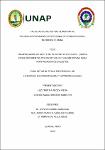| dc.contributor.advisor | Guerra Sangama, Wilson | |
| dc.contributor.advisor | Vásquez Chumbe, Jessy Patricia | |
| dc.contributor.advisor | Tello Célis, Fernando | |
| dc.contributor.author | Aroca Viena, Luz Cristina | |
| dc.contributor.author | Proaño Panduro, Jenifer Isaura | |
| dc.date.accessioned | 2021-04-26T16:05:08Z | |
| dc.date.available | 2021-04-26T16:05:08Z | |
| dc.date.issued | 2020 | |
| dc.identifier.uri | https://hdl.handle.net/20.500.12737/7224 | |
| dc.description.abstract | conlleva al padecimiento de enfermedades no trasmisibles a mediano o largo plazo, y esta condición pasa a ser un problema de salud pública, tanto nacional como internacional. No obstante, existen estrategias para ayudar a mejorar la calidad de vida de las personas y evitar el incremento de anemia y otras enfermedades en el mundo. Dentro de las estrategias se presentan la fortificación y microencapsulación de alimentos. En esta investigación se encapsuló aceite de Plukenetia volubilis L. (Sacha inchi) en micropartículas de pectina mediante el método de gelificación iónica. Las cuales se le añadió sangre bovino en cuatro concentraciones acuosas (4, 6, 8 y 10%). De estas cuatro concentraciones se prosiguió a elegir al tratamiento de mayor contenido de proteína para ser expuesta a condiciones gastrointestinales in vitro. Seguidamente ser liofilizada, y con ello formular tres niveles de fortificación (5, 10 y 15%), además de un producto sin fortificar (0%) para luego ser añadida a galletas. Las galletas fortificadas fueron analizadas de acuerdo a su composición centesimal, análisis microbiológico y evaluación de atributos sensoriales. Respecto a la composición centesimal, el contenido de hierro fue mayor en las galletas fortificadas con 5, 10 y 15% (11.55 mgr/100gr, 12.35 mgr/100gr, 12.59 mgr/100gr, respectivamente) que la galleta sin fortificar 6.17 mgr/100gr. Y según la diferencia en el contenido de micropartículas utilizadas, el nivel de fortificación 5% influye positivamente en el perfil sensorial del producto. En cuanto al sabor fue mayor en ser agradable. Y aumenta la sensación de crocantes de las mismas. Además, se encontró diferencia significativa (valor p=0,001) entre los tratamientos de galletas con nivel de fortificación de 0, 5, 10 y 15%. Por lo tanto, el uso de micropartículas de pectina recubiertas con sangre bovino en los alimentos puede ser utilizado con fines alimentarios y ser considerado como una estrategia adicional para los programas sociales de apoyo alimentario. | es_PE |
| dc.description.abstract | The deficient consumption of micronutrients in the daily diet leads to the suffering of non-communicable diseases in the medium or long term, and this condition becomes a public health problem, both nationally and internationally. However, there are strategies to help improve people's quality of life and prevent the increase in anemia and other diseases in the world. Among the strategies are food fortification and microencapsulation. In this research, Plukenetia volubilis L. (Sacha inchi) oil was encapsulated in pectin microparticles using the ionic gelation method. To which bovine blood was added in four aqueous concentrations (4, 6, 8 and 10%). From these four concentrations, it was continued to choose the treatment with the highest protein content to be exposed to gastrointestinal conditions in vitro. It will then be lyophilized, and thus formulate three levels of fortification (5, 10 and 15%), in addition to an unfortified product (0%) to later be added to cookies. The fortified cookies were analyzed according to their centesimal composition, microbiological analysis and evaluation of sensory attributes. Regarding the centesimal composition, the iron content was higher in the fortified biscuits with 5, 10 and 15% (11.55 mgr / 100gr, 12.35 mgr / 100gr, 12.59 mgr / 100gr, respectively) than the unfortified biscuit 6.17 mgr / 100gr. And depending on the difference in the content of microparticles used, the 5% fortification level positively influences the sensory profile of the product. As for the flavor, it was more pleasant. And it increases the crunchiness of them. In addition, a significant difference was found (p value = 0.001) between the biscuit treatments with a fortification level of 0, 5, 10 and 15%. Therefore, the use of pectin microparticles coated with bovine blood in food can be used for food purposes and be considered as an additional strategy for social food support programs. | es_PE |
| dc.format | application/pdf | es_PE |
| dc.language.iso | spa | es_PE |
| dc.publisher | Universidad Nacional de la Amazonía Peruana | es_PE |
| dc.rights | info:eu-repo/semantics/openAccess | es_PE |
| dc.rights.uri | https://creativecommons.org/licenses/by/4.0/ | es_PE |
| dc.subject | Encapsulación | es_PE |
| dc.subject | Aceites vegetales | es_PE |
| dc.subject | Sacha inchi | es_PE |
| dc.subject | Plukenetia voluvilis | es_PE |
| dc.subject | Fortificación de alimentos | es_PE |
| dc.subject | Galletas | es_PE |
| dc.title | Encapsulación de aceitede Plukenetia volubilis L. (sacha inchi) recubiertas con proteínas de sangre bovina para fortificación de galletas | es_PE |
| dc.type | info:eu-repo/semantics/bachelorThesis | es_PE |
| thesis.degree.discipline | Bromatología y Nutrición Humana | es_PE |
| thesis.degree.grantor | Universidad Nacional de la Amazonía Peruana. Facultad de Industrias Alimentarias | es_PE |
| thesis.degree.name | Licenciado(a) en Bromatología y Nutrición Humana | es_PE |
| dc.subject.ocde | http://purl.org/pe-repo/ocde/ford#3.03.05 | es_PE |
| renati.author.dni | 70760470 | |
| renati.author.dni | 76645243 | |
| renati.advisor.orcid | https://orcid.org/0000-0003-4949-9159 | es_PE |
| renati.advisor.orcid | https://orcid.org/0000-0002-1800-5366 | es_PE |
| renati.advisor.dni | 05221589 | |
| renati.advisor.dni | 05391577 | |
| renati.advisor.dni | 05374789 | |
| renati.type | http://purl.org/pe-repo/renati/type#tesis | es_PE |
| renati.discipline | 918016 | es_PE |
| renati.level | http://purl.org/pe-repo/renati/level#tituloProfesional | es_PE |
| renati.juror | Trevejo Chávez, Elmer | |
| renati.juror | Bazán Ferrando, Alberto José | |
| renati.juror | Alva Angulo, Miriam Ruth | |
| dc.publisher.country | PE | es_PE |


